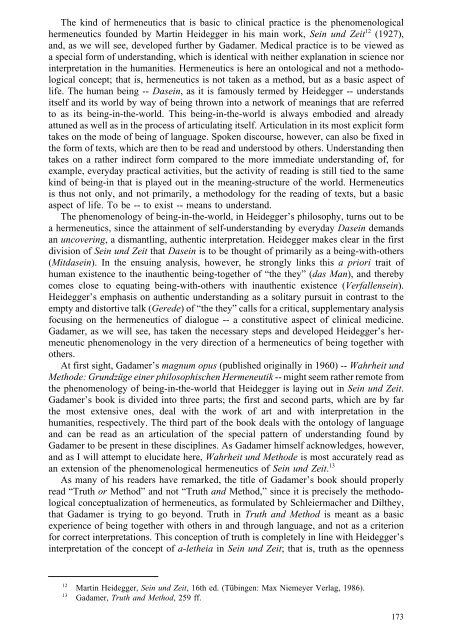[Andrzej_Wiercinski_(ed ... - WordPress.com
[Andrzej_Wiercinski_(ed ... - WordPress.com
[Andrzej_Wiercinski_(ed ... - WordPress.com
Create successful ePaper yourself
Turn your PDF publications into a flip-book with our unique Google optimized e-Paper software.
The kind of hermeneutics that is basic to clinical practice is the phenomenologicalhermeneutics found<strong>ed</strong> by Martin Heidegger in his main work, Sein und Zeit 12 (1927),and, as we will see, develop<strong>ed</strong> further by Gadamer. M<strong>ed</strong>ical practice is to be view<strong>ed</strong> asa special form of understanding, which is identical with neither explanation in science norinterpretation in the humanities. Hermeneutics is here an ontological and not a methodologicalconcept; that is, hermeneutics is not taken as a method, but as a basic aspect oflife. The human being -- Dasein, as it is famously term<strong>ed</strong> by Heidegger -- understandsitself and its world by way of being thrown into a network of meanings that are referr<strong>ed</strong>to as its being-in-the-world. This being-in-the-world is always embodi<strong>ed</strong> and alreadyattun<strong>ed</strong> as well as in the process of articulating itself. Articulation in its most explicit formtakes on the mode of being of language. Spoken discourse, however, can also be fix<strong>ed</strong> inthe form of texts, which are then to be read and understood by others. Understanding thentakes on a rather indirect form <strong>com</strong>par<strong>ed</strong> to the more imm<strong>ed</strong>iate understanding of, forexample, everyday practical activities, but the activity of reading is still ti<strong>ed</strong> to the samekind of being-in that is play<strong>ed</strong> out in the meaning-structure of the world. Hermeneuticsis thus not only, and not primarily, a methodology for the reading of texts, but a basicaspect of life. To be -- to exist -- means to understand.The phenomenology of being-in-the-world, in Heidegger’s philosophy, turns out to bea hermeneutics, since the attainment of self-understanding by everyday Dasein demandsan uncovering, a dismantling, authentic interpretation. Heidegger makes clear in the firstdivision of Sein und Zeit that Dasein is to be thought of primarily as a being-with-others(Mitdasein). In the ensuing analysis, however, he strongly links this a priori trait ofhuman existence to the inauthentic being-together of “the they” (das Man), and thereby<strong>com</strong>es close to equating being-with-others with inauthentic existence (Verfallensein).Heidegger’s emphasis on authentic understanding as a solitary pursuit in contrast to theempty and distortive talk (Ger<strong>ed</strong>e) of “the they” calls for a critical, supplementary analysisfocusing on the hermeneutics of dialogue -- a constitutive aspect of clinical m<strong>ed</strong>icine.Gadamer, as we will see, has taken the necessary steps and develop<strong>ed</strong> Heidegger’s hermeneuticphenomenology in the very direction of a hermeneutics of being together withothers.At first sight, Gadamer’s magnum opus (publish<strong>ed</strong> originally in 1960) -- Wahrheit undMethode: Grundzüge einer philosophischen Hermeneutik -- might seem rather remote fromthe phenomenology of being-in-the-world that Heidegger is laying out in Sein und Zeit.Gadamer’s book is divid<strong>ed</strong> into three parts; the first and second parts, which are by farthe most extensive ones, deal with the work of art and with interpretation in thehumanities, respectively. The third part of the book deals with the ontology of languageand can be read as an articulation of the special pattern of understanding found byGadamer to be present in these disciplines. As Gadamer himself acknowl<strong>ed</strong>ges, however,and as I will attempt to elucidate here, Wahrheit und Methode is most accurately read asan extension of the phenomenological hermeneutics of Sein und Zeit. 13As many of his readers have remark<strong>ed</strong>, the title of Gadamer’s book should properlyread “Truth or Method” and not “Truth and Method,” since it is precisely the methodologicalconceptualization of hermeneutics, as formulat<strong>ed</strong> by Schleiermacher and Dilthey,that Gadamer is trying to go beyond. Truth in Truth and Method is meant as a basicexperience of being together with others in and through language, and not as a criterionfor correct interpretations. This conception of truth is <strong>com</strong>pletely in line with Heidegger’sinterpretation of the concept of a-letheia in Sein und Zeit; that is, truth as the openness1213Martin Heidegger, Sein und Zeit, 16th <strong>ed</strong>. (Tübingen: Max Niemeyer Verlag, 1986).Gadamer, Truth and Method, 259 ff.173


